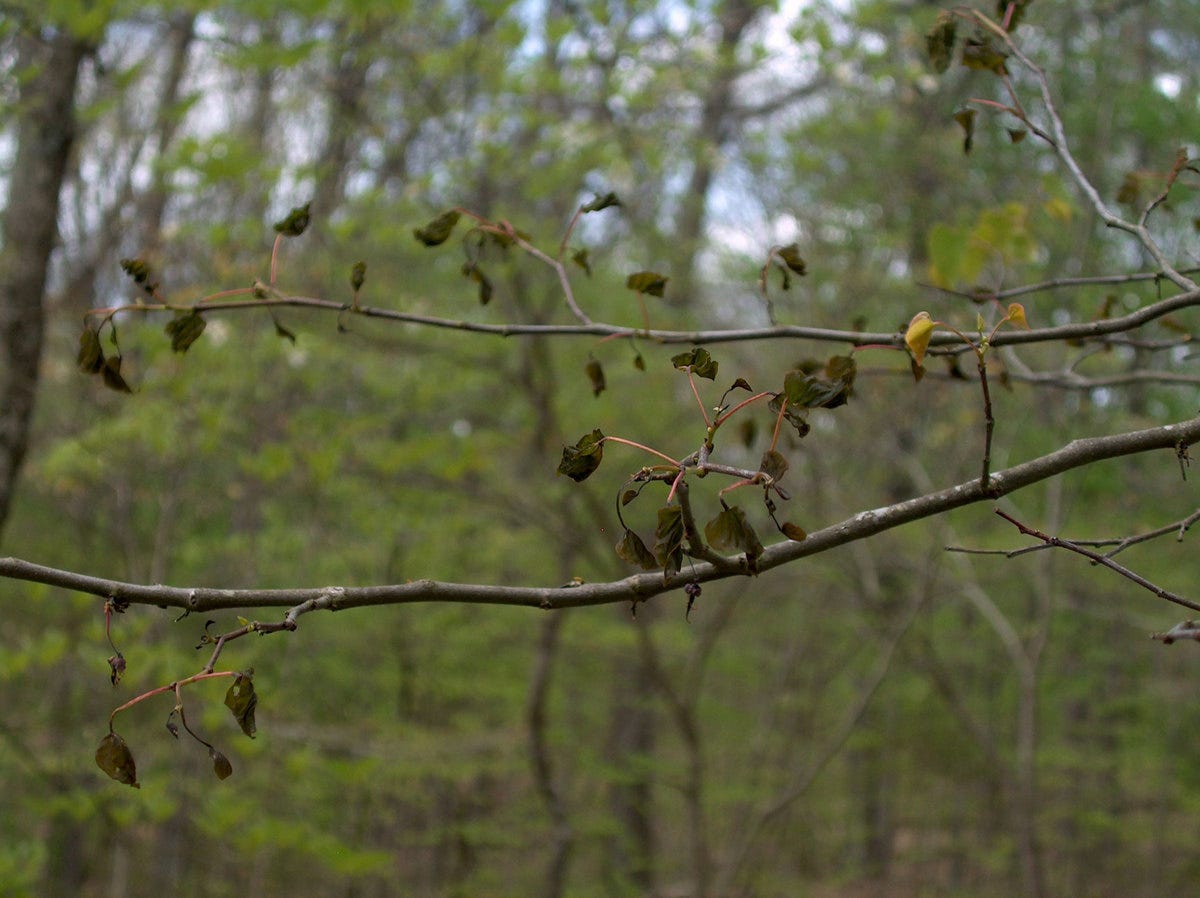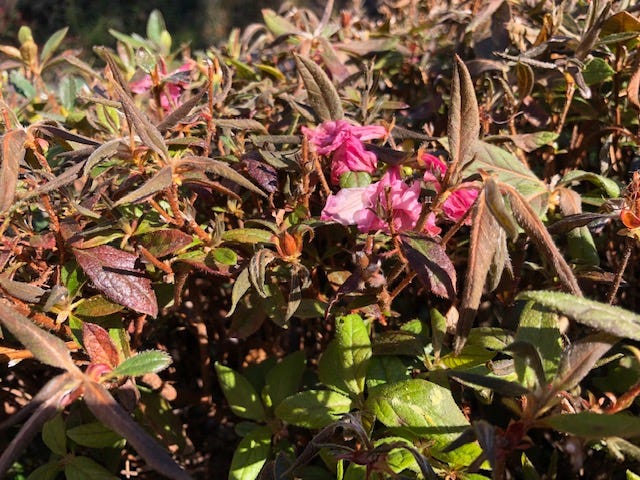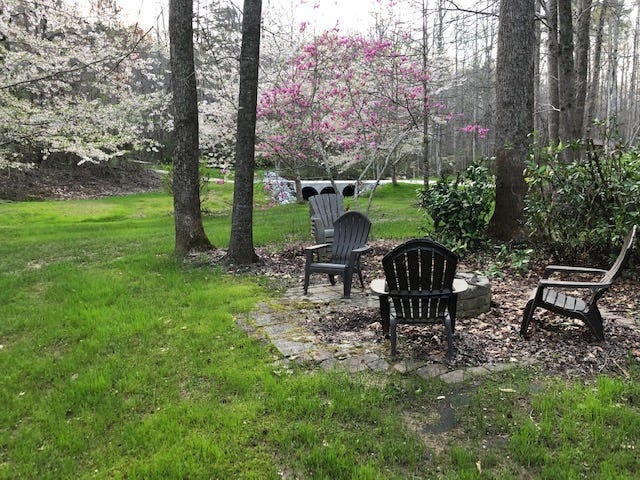Welcome to Natural Wonders! Here in the northern hemisphere it’s the most wonderful time of year - when Nature awakens from her long winter sleep and produces green where grey used to be! Hopefully you’re experiencing the wonders of Nature wherever you are, but even if you’re not — here’s some Nature for your inbox…
As predicted by our southern groundhog, General Beauregard Lee, we have experienced an early spring here in the southern United States. By late February our daffodils were finishing up and the peach trees and cherry trees were already blooming.
It’s a beautiful time of year, but it’s arrived nerve-rackingly early since we aren’t out of the woods when it comes to hard frosts or even snow. One spring, about ten years ago, we experienced extremely cold temperatures when the trees had already leafed out. It killed all the baby leaves.
Since trees produce their buds for new leaves during the previous fall, how in the world does a tree suddenly produce brand new leaves at a moment’s notice? Does that process weaken the tree? Could it even kill it?
With a series of hard frosts imminent in our area, I thought I’d try to find out:
How can newborn tree leaves survive an early frost?
Spring is an amazing time. The trees have been “hibernating” for months and finally begin to wake up, their sap warming beneath the bark and slowly creeping through their branches and trunk. How do they know when winter is over? Many trees “tell time” by measuring the amount of sunlight available each day. I’ve written before about how beech trees retain their leaves until the lengthening spring days produce at least 13 hours of sunlight.
If it’s surprising that trees can tell time, it’s also fascinating to note that they protect their newborn leaves with a type of sunscreen. These leaves are “born” with a reddish hue from anthocyanin, the same pigment that makes some autumn leaves appear red.
Gradually, the baby leaves lose this pigmentation and go to town producing food for the tree using green chlorophyll.
Next time you’re outside, take a look at the tiny leaves bursting forth and see if you can find evidence of this natural sunblock – some trees use it only briefly when the leaves begin to open. You’ll probably also notice, in your wanderings, that the smaller saplings on the forest floor tend to leaf out before the larger giants overhead. This is by design – smaller trees are given a week or two head start to soak up as much sunlight as possible before the Big Kids block the overhead light with their large leaves. How do they get this head start? The air is actually warmer in the lower sections of the forest as the soils begin to wake up. Cold winds and frost may still pummel the trees 60 to 100 feet overhead, while the younger saplings enjoy a warming earth.
These tiny leaves that burst forth in the spring were created months before, in the waning days of summer. In a normal year, trees spend the spring and early summer putting their energy toward overall growth, but as the summer starts to fade and fall approaches, they begin creating tiny leaf buds on their branches. This preparation ahead of time is necessary because trees are inactive during wintertime. Producing leaf buds requires lots of energy, which can only happen when the leaf-based energy factory is chugging along overhead.
So, what happens when these precious leaf buds and baby leaves are hit by frost?

Hard frosts, when the air and ground freezes, can cause the water inside plant cells to freeze. When the morning sunlight warms the cells, the leaf shrivels and dies. I was surprised to find out that temperatures have to be well below freezing to cause much damage. New growth can typically survive temperatures down to the upper 20s. Below that, newborn leaves are irreparably damaged and the trees have to start all over again.
These “second-cohort” leaves are miraculously produced by the tree using the stored carbohydrates in their branches. But it doesn’t happen quickly. Scientists have learned that it takes 48 days for a beech tree to refoliate – that’s over a month of lost opportunity for the tree to get its chlorophyll engines running. However, the trees seemed to make up for this late start by continuing to retain their green leaves and produce energy two weeks later into the fall than normal years.
During these years when trees have to scramble to recreate leaves, they tend not to grow as much in height and width – understandable, since so much energy was spent early on in re-producing leaves. Those leaves also tend to be smaller than leaves in a normal year. The good news, however, is that trees damaged by spring frost produced more buds in the autumn in preparation for the following spring – 66% more buds than if they’d not experienced a hard frost. It’s as if they’re preparing to make up for a lost year of growth by overpreparing for next spring.
What about flowering trees and shrubs?


While trees and shrubs will refoliate frost-bitten leaves, the same is not true of their blossoms. Trees can afford to lose some or most of their blossoms and still survive the coming year. But losing all their leaves? That’s a death sentence for a tree.
The critical temperature at which blooms are killed changes based on their stage of development. There’s a great chart here that gives you the survival rate for various fruit trees based on these factors. For instance, we have acres and acres of peach trees near us in differing stages of bloom. I’ve been really worried that the hard frost this week will greatly impact the coming Georgia peach season.
According to the chart, yesterday morning’s 29-degree temps (-2 degrees Celsius) might affect about 10% of the crop since several of the trees have already dropped their flowers and are working to produce tiny peaches. Peaches form inside the base of a peach flower. After the petals fall off, a floral cup called a shuck contains the growing peach. If a frost hits while the baby peach is safe inside the shuck, it will be fine. But if the baby peach is touching the sides of the shuck or has split it open, freezing temperatures will kill the peach on the branch.

For those peach varieties that are still in the Pink stage, temps can get all the way down to 25 degrees (-4 degrees Celsius) before farmers have to worry. The earlier the stage, the colder it can get without damaging the trees. As long as our temperatures don’t get any colder, our delicious peaches should be ok.
Unfortunately, the frequency of leaf-killing cold frosts is increasing with global warming. As warmer spring weather causes trees to leaf-out earlier, they become much more likely to get hit by a sudden hard frost. One study suggests that by the end of this century, spring will arrive 10 days earlier than it does now, making trees and their early leaves and blooms much more vulnerable to late frosts.
Weird Nature:

Detritus:
It’s no surprise that dogs can sniff out drugs and even sense seizures before they happen. But ants that can sniff out cancer in urine?
If you like photographs of colorful tiny objects, you’ll love these winners of photomicrography — photos through light microscopes.
In Denmark, the Nordic concept of friluftsliv – or unwinding in the outdoors – includes troll hunts, shoreline biking and stargazing in Scandinavia's first International Dark Sky Park.
If you have to use a horse scale to weigh the fish, you can tell whatever fish story you want…
I imagine people who are members of the Cloud Appreciation Society are my kind of peeps
If you liked this issue, please click the “like” button below - it makes me happy and also raises the profile of this newsletter!








What a great article! I had never appreciated the stages of peach blossom and fruit development had specific names. I'll be watching the buds on our peach trees closely this spring in our cool temperate garden here in Australia.
Very informative and thorough!